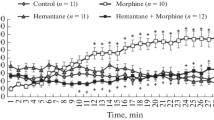Abstract
Naltrindole (NTI) and naltriben (NTB), a benzofuran derivative of NTI, were recently synthesized as highly selective δ-opioid receptor antagonists. Both NTI and NTB failed to suppress the antinociceptive effect induced by morphine. In contrast, both NTI and NTB significantly suppressed the morphine-induced hyperlocomotion and increase in turnover of dopamine (DA) in the mouse limbic forebrain. These results suggest that δ-opioid receptors play, at least in part, a role in the morphine-induced hyperlocomotion and excitation of mesolimbic DA systems, but not antinociception.
Similar content being viewed by others
Abbreviations
- β-FNA:
-
β-funaltrexamine hydrochloride
- DA:
-
dopamine
- DOPAC:
-
3,4-dihydroxyphenylacetic acid
- HVA:
-
homovanillic acid
- HPLC-ECD:
-
high-performance liquid chromatography with electrochemical detection
- NTB:
-
naltriben methanesulfonate hydrate
- NTI:
-
naltrindole hydrochloride
References
Bozarth MA (1987) Neuroanatomical boundaries of the reward-relevant opiate-receptor field in the ventral tegmental area as mapped by the conditioned place preference method in rats. Brain Res 414:77–84
Di Chiara G, Imperato A (1988) Opposite effects of mu and kappa opiate agonists on dopamine release in the nucleus accumbens and in the dorsal caudate of freely moving rats. J Pharmacol Exp Ther 244:1067–1080
Hirabayashi M, Alam MR (1981) Enhancement effect of methamphetamine on ambulatory activity produced by repeated administration in mice. Pharmacol Biochem Behav 15:925–932
Latimer LG, Duffy P, Kalivas PW (1987) Mu opioid receptor involvement in enkephalin activation of dopamine neurons in the ventral tegmental area. J Pharmacol Exp Ther 241:328–337
Liu-Chen L-Y, Li S, Wheeler-Aceto H, Cowan A (1991) Effects of intracerebroventricular β-funaltrexamine on μ and δ opioid receptors in the rat: dichotomy between binding and antinociception. Eur J Pharmacol 203:195–202
Longoni R, Spina L, Mulas A, Carboni E, Garau L, Melchiorri P, Di Chiara G (1991) (D-Ala2) deltorphin II: D1-dependent stereotypes and stimulation of dopamine release in the nucleus accumbens. J Neurosci 11:1565–1576
Mansour A, Khachaturian H, Lewis ME, Akil H, Watson SJ (1988) Anatomy of CNS opioid receptors. TINS 11:308–314
Menkens K, Bilsky EJ, Wild KD, Portoghese PS, Reid LD, Porreca F (1992) Cocaine place preference is blocked by the δ-opioid receptor antagonist, naltrindole. Eur J Pharmacol 219:345–346
Narita M, Suzuki T, Misawa M, Nagase H (1990) Effects of kappa opioids on the morphine-induced pharmacological actions. Eur J Pharmacol 183:2328
Narita M, Suzuki T, Funada M, Misawa M, Nagase H (1993) Blockade of the morphine-induced increase in turnover of dopamine on the mesolimbic dopaminergic system by κ-opioid receptor activation in mice. Life Sci 52:397–404
Portoghese PS, Sultana M, Takemori AE (1988) Naltrindole, a highly selective and potent non-peptide δ opioid receptor antagonist. Eur J Pharmacol 146:185–186
Portoghese PS, Sultana M, Takemori AE (1990) Design of peptidomimetic δ opioid antagonists using the message-address concept. J Med Chem 33:1714–1720
Portoghese PS, Nagase H, MaloneyHuss KE, Lin C-E, Takemori AE (1991) Role of spacer and address components in peptidomimetic δ opioid receptor antagonists related to naltrindole. J Med Chem 34:1715–1720
Rothman RB, Long JB, Bykov V, Jacobson AE, Rice KC, Holaday JW (1988) β-FNA binds irreversibly to opiate receptor complex: in vivo and vitro evidence. J Pharmacol Exp Ther 247:405–416
Sanchez-Blazquez P, Garzon J (1989) Evaluation of δ receptor mediation of supraspinal opioid analgesia by in vivo protection against the β-funaltrexamine antagonist effect. Eur J Pharmacol 159:9–23
Sofuoglu M, Portoghese PS, Takemori AE (1991) Differential antiagonism of delta opioid agonists by naltrindole (NTI) and its benzofuran analog (NTB) in mice: evidence for delta opioid receptor subtypes. J Pharmacol Exp Ther 257:676–680
Ward SJ, Portoghese PS, Takemori AE (1982) Pharmacological profiles of β-funaltrexamine (β-FNA) and β-chlornaltrexamine (β-CNA) on the mouse vas deferens preparation. J Pharmacol Exp Ther 80:377–384
Author information
Authors and Affiliations
Rights and permissions
About this article
Cite this article
Narita, M., Suzuki, T., Funada, M. et al. Involvement of δ-opioid receptors in the effects of morphine on locomotor activity and the mesolimbic dopaminergic system in mice. Psychopharmacology 111, 423–426 (1993). https://doi.org/10.1007/BF02253531
Received:
Revised:
Issue Date:
DOI: https://doi.org/10.1007/BF02253531




